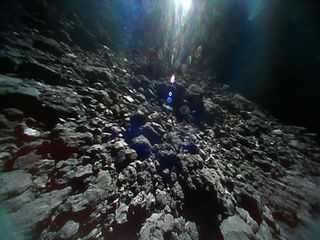Japan's pioneering asteroid hoppers have finally gotten names.
The tiny explorers made history in September when they deployed from their mothership, the Hayabusa2 spacecraft, and touched down on the near-Earth asteroid Ryugu. Before then, no mobile rover had ever successfully landed on an asteroid, let alone explored one.
To date, the duo have been known as MINERVA-II1A and MINERVA-II1B, which are more designations than names. But that has changed: MINERVA-II1A is now called HIBOU, which is short for "Highly Intelligent Bouncing Observation Unit" and also French for "horned owl," while its sibling is OWL ("Observation unit with intelligent Wheel Locomotion"), Japan Aerospace Exploration Agency (JAXA) officials announced yesterday (Dec. 13). [Japan's Hayabusa2 Asteroid Ryugu Mission in Pictures]

"In Roman mythology, Minerva is the goddess of music, poetry, medicine, wisdom, commerce, weaving, crafts and magic," JAXA officials wrote in a statement.
"Works of art of the goddess frequently show her with an owl, which is considered her sacred creature and a symbol of wisdom," the officials added. "We therefore named our rovers after Minerva's symbol of the owl. As the two rovers are slightly different from one another, we named them after the owl and the horned owl."
Get the Space.com Newsletter
Breaking space news, the latest updates on rocket launches, skywatching events and more!
HIBOU and OWL each weigh about 2.4 lbs. (1.1 kilograms) and measure 7 inches wide by 2.8 inches tall (18 by 7 centimeters). They carry a variety of scientific gear between them, including seven cameras, which have snapped stunning up-close views of the 3,000-foot-wide (900 meters) Ryugu's surface.

Despite the "wheel" in OWL's full name, the solar-powered rovers don't roll along; rather, they hop, with the aid of internal rotating motors.
The $150 million Hayabusa2 mission launched in December 2014 and arrived in orbit around Ryugu this past June. The Hayabusa2 mothership also dropped a shoebox-size lander on the asteroid's surface less than two weeks after HIBOU and OWL deployed. This German-built probe, called MASCOT ("Mobile Asteroid Surface Scout"), studied the space rock for 17 hours before its battery died.
Hayabusa2 is still carrying yet another hopper, MINERVA-II2, which will head down to Ryugu sometime next year. (In case you were wondering, MINERVA stands for "Micro Nano Experimental Robot Vehicle for Asteroid." And there was a MINERVA hopper on Japan's original Hayabusa mission, but that little probe didn't succeed in landing on its space-rock target, the stony asteroid Itokawa. So, that explains the "MINERVA-II" business.)
The Hayabusa2 orbiter will also touch Ryugu's surface in 2019, in order to snag samples that will come down to Earth in December 2020, if all goes according to plan.
Data gathered by the mothership and the smaller probes, and by scientists here on Earth inspecting the returned sample, should shed light on the solar system's early days and the role that carbon-rich asteroids such as Ryugu may have played in helping life get started on our planet, JAXA officials have said.
A NASA probe with similar objectives is working at a different asteroid now as well. The OSIRIS-REx spacecraft arrived at its target, the 1,640-foot-wide (500 m), carbon-rich asteroid Bennu, on Dec. 3. OSIRIS-REx is scheduled to grab samples in 2020 and get them to Earth in September 2023.
Mike Wall's book about the search for alien life, "Out There" (Grand Central Publishing, 2018; illustrated by Karl Tate), is out now. Follow him on Twitter @michaeldwall. Follow us @Spacedotcom or Facebook. Originally published on Space.com.
Join our Space Forums to keep talking space on the latest missions, night sky and more! And if you have a news tip, correction or comment, let us know at: community@space.com.

Michael Wall is a Senior Space Writer with Space.com and joined the team in 2010. He primarily covers exoplanets, spaceflight and military space, but has been known to dabble in the space art beat. His book about the search for alien life, "Out There," was published on Nov. 13, 2018. Before becoming a science writer, Michael worked as a herpetologist and wildlife biologist. He has a Ph.D. in evolutionary biology from the University of Sydney, Australia, a bachelor's degree from the University of Arizona, and a graduate certificate in science writing from the University of California, Santa Cruz. To find out what his latest project is, you can follow Michael on Twitter.
